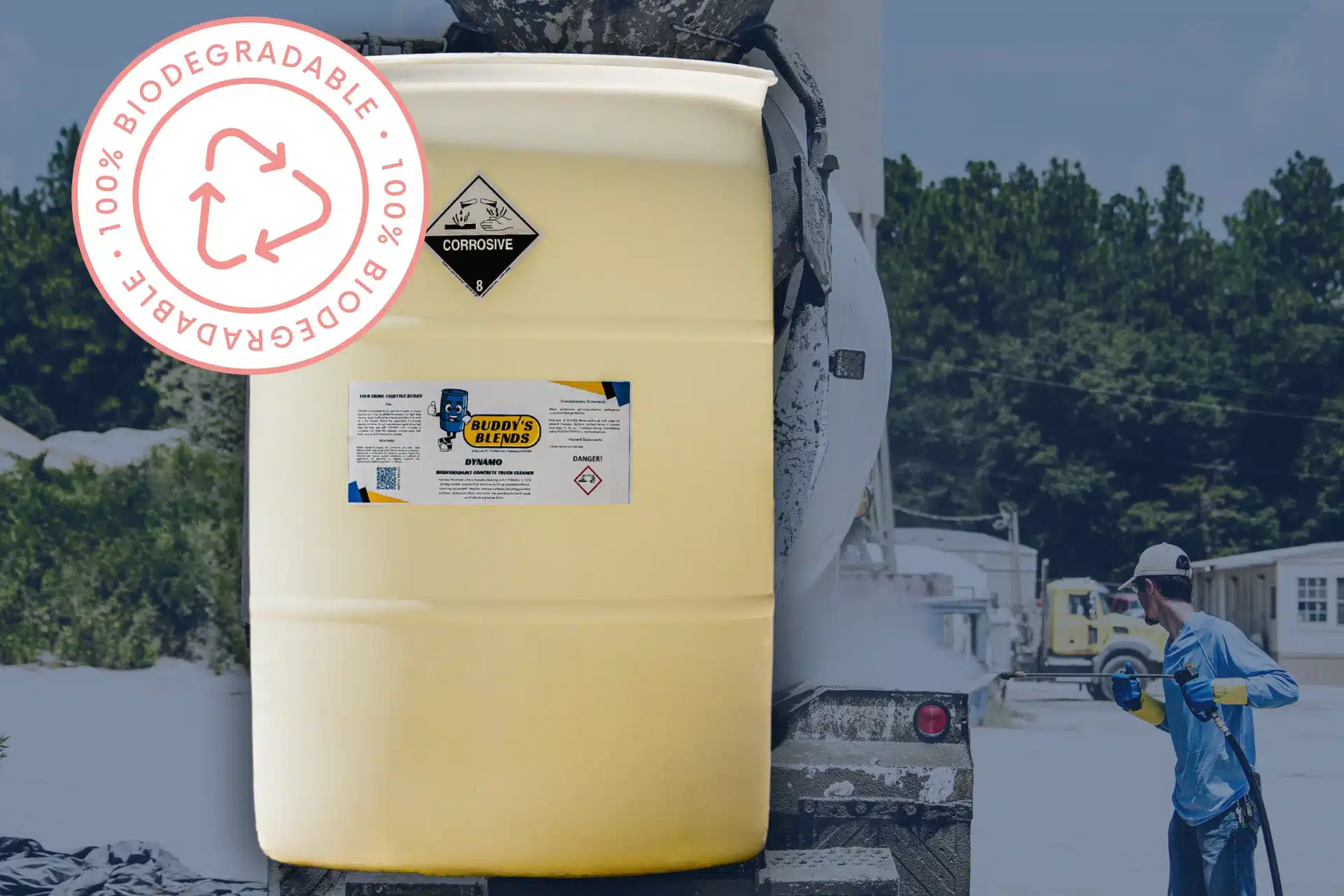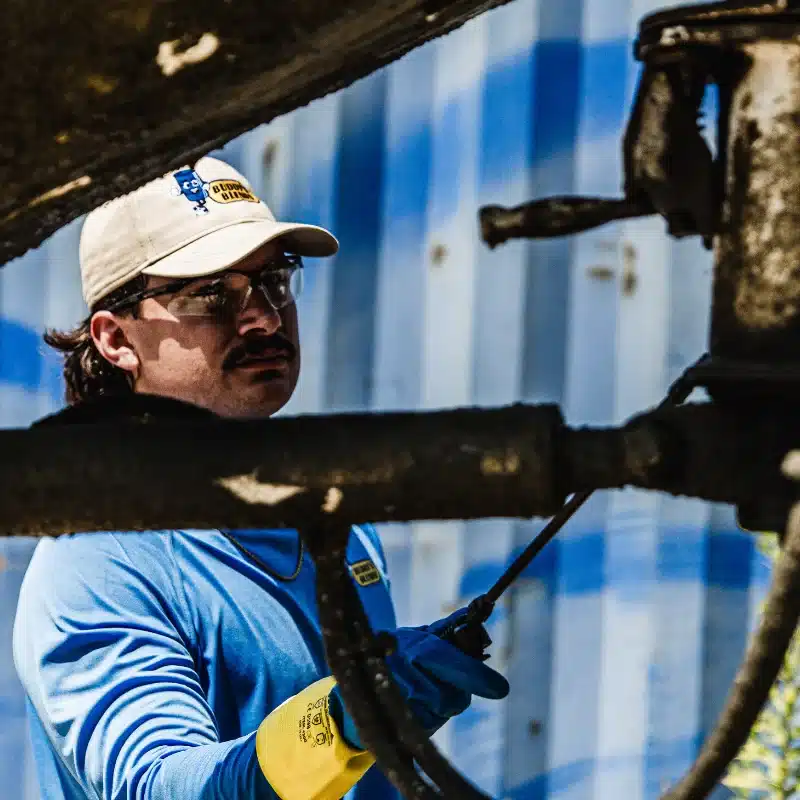
Prioritize safety for your employees and for your long-term success
When it comes to handling hazardous chemical cleaners for industrial maintenance, safety isn’t just a box to check – it’s essential for protecting your team and ensuring smooth operations. Proper safety protocols help prevent accidents, minimize liability, and keep your business in line with regulatory standards.
Whether you’re removing heavy equipment grime or tackling concrete buildup, here are key safety measures to follow:
1. Hazard Communication (HAZCOM)
A strong hazard communication system ensures that employees are well-informed about the chemicals they work with. Following Occupational Safety and Health Administration’s (OSHA) Hazard Communication Standard (HCS) in the workplace includes:
- Maintaining an up-to-date inventory of all hazardous chemicals in the workplace, from cleaning agents to manufacturing substances.
- Labeling all containers correctly, including the product name, signal word (e.g., “Warning”), hazard pictograms, precautionary statements, and supplier information in clear, legible English.
- Providing easy access to Safety Data Sheets (SDS) for all hazardous chemicals.
- Implementing employee training programs to ensure workers understand proper handling, storage, and protective measures. OSHA requires safety training for the proper handling of hazardous materials and use of PPE. Training should take place before an employee starts work and/or when a new chemical is introduced. Having a review of training each year is advisable to ensure that all employees are aware of and keep up with any protocols and precautionary measures.
Safe storage of hazardous chemicals ensures that chemicals are in appropriate containers and properly sealed and labelled in a dry, well-ventilated area. Use of a secondary containment system is needed to ensure that if there is a spill it will not spread out of the designated area. Segregate chemicals by hazard classification, such as storing flammable liquids together. Keep SDS and manufacturer information nearby. In the event of an accident, they can be referenced and readily available to emergency responders or medical personnel.
Make sure that employees are properly trained in the event of any dangerous exposure to hazardous, toxic materials. Prompt and appropriate mitigation measures will help to keep employees safe and prevent more serious injuries from occurring. It should be clear who they should contact in the event of an emergency.
Keep a record of any risk assessment, waste analysis, employee health monitoring, and employees who work with carcinogens. Make sure that you have explicit written procedures for emergencies, waste minimization, and training.

2. OSHA violations – fines
| Rank | Violation category |
|---|---|
| 1 | Fall Protection – General Requirements (1926.501) |
| 2 | Ladders (1926.1053) |
| 3 | Hazard Communication (1910.1200) |
| 4 | Lockout/Tagout (1910.147) |
| 5 | Respiratory Protection (1910.134) |
| 6 | Scaffolding (1926.451) |
| 7 | Personal Protective and Lifesaving Equipment – Eye and Face Protection (1926.102) |
| 8 | Powered Industrial Trucks (1910.178) |
| 9 | Fall Protection – Training Requirements (1926.503) |
| 10 | Machine Guarding (1910.212) |
Small businesses can take proactive steps by conducting self-inspections using OSHA’s Small Business Safety and Health Handbook to conduct a workplace self-inspection to identify, monitor, and control workplace hazards.
3. Personal Protective Equipment (PPE)
Why PPE is so important
PPE is a critical line of defense when working with hazardous chemicals. Exposure risks vary based on chemical type, concentration, and exposure duration.
Not all hazardous chemicals are considered toxic. Some chemicals can be hazardous due to the risk of fire or explosion, but not toxic in smaller quantities. Toxicity depends on:
- How much of a chemical is needed to cause harm
- The method and duration of exposure
- How much enters the body
- Whether there are multiple exposures (of the same or multiple substances)
- Individual susceptibility
Chemicals can enter the body through:
- Inhalation
- Skin or eye contact
- Ingestion
Generally, the longer the exposure, the greater the chance of being affected by it. Some chemicals will affect people only over a certain threshold, whereas others, such as carcinogens, do not have a threshold. If a chemical is toxic, there can be acute/immediate injury upon exposure, whereas others can result in chronic effects, such as damage to certain organs over time. If exposed to multiple toxic chemicals, it is possible that there will be additional effects:
- Additive effects: when similar chemicals cause similar effects that ‘add up’
- Synergistic effects: when multiple chemicals’ effects are greater than their individual effects
- Potentiating effects: when the effect of one substance increases exposure to another substance.
Exposure to toxic chemicals can lead to nausea/vomiting, cancer, nervous system disorders, chemical burns, reproductive defects, organ disorders, skin irritation, and headaches. Determining how toxic chemicals interact together and their long-term effect on humans is still being studied and not fully understood. Individuals vary in how susceptible they are to toxic chemicals.
Therefore, it is important for employers to do their best to reduce the risk to employees in the workplace by providing the training, tools, and equipment that will keep employees informed and safe in the workplace. This will also reduce any possible legal or regulatory issues in the future.

Considerations when selecting appropriate PPE
The key is to minimize any contact with hazardous chemicals by using the minimum amount needed to get the job done and by ensuring that employees are properly outfitted in appropriate clothing and protective equipment. Moreover, having employees rotate between jobs involving hazardous substances and those that do not is advisable to reduce exposure.
- Respiratory protective equipment: Should cover the mouth and nose and be appropriate to the type of exposure. There are air-purifying respirators (APRs) and atmosphere-supplying respirators (ASRs), the latter of which have a separate air supply, each with varying levels of protection depending upon the make and type. Before determining the level of protection needed, it is necessary to monitor and quantify the employee exposure in your workplace to ensure that the respirator protection level is appropriate. It is key that employees are properly trained in how to wear these and that the equipment iswell-maintained and replaced or repaired as necessary. Some individuals may not be able to wear respiratory protection, especially for prolonged periods, due to health issues. This should be taken into consideration when assigning roles and assessing risks.
- Protective clothing: Can include full-body or partial-body protection. Many employers provide chemical resistant coveralls or aprons rather than rely on employees to wear chemical resistant clothing. Common chemical resistant materials include butyl, neoprene, nitrile, polyvinyl chloride (PVC), polyvinyl alcohol (PVA), Viton, and SilverShield. Any area that may be exposed to the chemical should be covered, such as arms, legs, feet (closed-toe shoes/boots), and face (face shield).
- Gloves: Sizing and material are key. Uncomfortable gloves are more likely to be removed, leading to a greater chance of injury. The fit should be snug (not too loose or too tight) and should allow for the necessary level of dexterity that the job calls for. Thicker gloves may offer more protection but may impede the job. When combined with protective sleeves, gloves should fit tightly together to minimize the chances of any chemical exposure between them. Over time, gloves may lose shape and will need to be replaced. The Argonne National Laboratory Glove Chart is an excellent resource for selecting glove material (reproduced below). Latex gloves, while chemical resistant, are less popular now than previously due to allergies and sensitization.
| Material | Advantages | Disadvantages |
|---|---|---|
| Natural rubber | Low cost, good physical properties, dexterity | Poor vs. oils, greases, organics. Frequently imported; may be poor quality |
| Natural rubber blends | Low cost, dexterity, better chemical resistance than natural rubber vs. some chemicals | Physical properties frequently inferior to natural rubber |
| Polyvinyl chloride (PVC) | Low cost, very good physical properties, medium cost, medium chemical resistance | Plasticizers can be stripped; frequently imported may be poor quality |
| Neoprene | Medium cost, medium chemical resistance, medium physical properties | NA |
| Nitrile | Low cost, excellent physical properties, dexterity | Poor vs. benzene, methylene chloride, trichloroethylene, many ketones |
| Butyl | Specialty glove, polar organics | Expensive, poor vs. hydrocarbons, chlorinated solvents |
| Polyvinyl alcohol (PVA) | Specialty glove, resists a very broad range of organics, good physical properties | Very expensive, water sensitive, poor vs. light alcohols |
| Fluoro-elastomer (Viton) ™ | Specialty glove, organic solvents | Extremely expensive, poor physical properties, poor vs. some ketones, esters, amines |
| Norfoil (Silver Shield) | Excellent chemical resistance | Poor fit, easily punctures, poor grip, stiff |
- Eye protection: Should have shatter-proof lens with lateral protection and impact-resistant frames. They should not only protect the eyes, but fit properly and be comfortable. Eye protection should not impede vision or movement and not interfere with any other PPE. If an employee uses prescription lenses, provide eye protection that can be worn over them (prescription eye protection can also be acquired). Common eye protection types include safety glasses (frames) and goggles (tight-fitting). For liquid chemicals, indirect vented or non-vented goggles are the most appropriate, whereas direct vented goggles are better for protection against large particles. Chemical safety goggles should have the ANSI Z87.1 D3 marking on them. Depending on the chemicals and conditions, it may be necessary to also wear a face shield over eye protection.
Tools such as the Ansell Guardian Chemical’s product selector, which lets you choose primary and additional hazards when searching for appropriate products, can help determine the kind and level of protection needed as well.
Further considerations
All PPE should be regularly inspected for damage and replaced or repaired as necessary. Chemical resistant materials, such as clothing or gloves, will never provide complete protection and protection will degrade over time due to use and chemical processes:
- Permeation: when the chemical dissolves in or moves through the material at a molecular level (not visible by the eye)
- Penetration: when the chemical moves through imperfections or weak points of the material (zippers, seams, etc.)
- Degradation: when the material is damaged to due chemical exposure or other use-related conditions
Therefore, protective clothing should be replaced regularly and according to the manufacturer’s breakthrough timeline. Reusable protective clothing should be washed and/or sterilized after each use. Dispose of PPE exposed to hazardous chemicals as hazardous waste.
Employees should employ good personal hygiene, such as washing hands after chemical use (even if they were wearing gloves). A first aid kit should be readily available in case of an accident or emergency. A properly labelled and maintained eyewash and body flush station should be provided in near proximity to where employees are working with dangerous chemicals. Every second matters in an emergency situation.
Use common sense and only use chemicals for their intended use. Do not eat, drink, or smoke hazardous substances. Keep away from children.
If you put good people in bad systems, you get bad results. You have to water the flowers you want to grow. – Stephen Covey
4. Storage
Chemical storage
- Work areas should be clean and orderly.
- Set aside a designated storage area.
- The storage area should be dry, well-ventilated, cool, and away from any heat sources.
- Keep like with like – store chemicals of the same hazard class together.
- Ensure shelving is sufficiently stable and strong.
- Store heavy items on the bottom.
- Store chemicals in upright, sealed, and appropriate containers in good condition with a secondary containment system.
- Ensure all chemicals are labeled correctly and labels are legible.
- Keep chemicals away from any food or drink areas.
- Inspect the chemical storage periodically.
- Clean up any leaks or spills immediately.
PPE storage
- PPE should be stored away from dust, moisture, sunlight, damaging chemicals, extreme temperatures, and impact.
- Store a designated, well-ventilated area.
- Do not with everyday wear.
5. Safer chemicals
When possible, consider substituting a less hazardous or nonhazardous chemical product to keep exposure to toxic substances to a minimum. For example, you can substitute acid cement removers for 100% biodegradable alternatives. Safer chemicals are cost-saving and efficient and can help businesses avoid employee injuries and illnesses along with any regulatory fines.
Resources like the California Department of Public Health (CDPH) Hazard Evaluation System and Information Service can help in evaluating the impact of hazardous products on workplace and employee health.
The Big Picture
Creating a safer work environment isn’t just about compliance—it’s about being a real steward and leader in the industry. By following best practices in hazard communication, PPE use, chemical storage, and emergency preparedness, businesses can prevent accidents, reduce liability, and promote a culture of safety.


